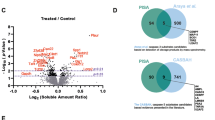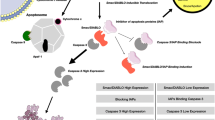Abstract
Inhibitor of apoptosis protein (IAP)-binding proteins such as Grim, Reaper and HID have been shown to exert a critical role in regulating caspase activity in species such as D. Melanogaster. However, a comparable role for the mammalian homologue of second mitochondrial-derived activator of caspase/direct IAP-binding protein with low pI (Smac/DIABLO) has yet to be clearly established in vivo. Despite tremendous interest in recent years in the use of so-called Smac mimetics to enhance chemotherapeutic potency, our understanding of the true physiologic nature of Smac/DIABLO in regulating programmed cell death (PCD) remains elusive. In order to critically evaluate the role of Smac/DIABLO in regulating mammalian PCD, deficiency of caspase-3 was used as a sensitizing mutation in order to reduce aggregate levels of executioner caspase activity. We observe that combinatorial deletion of Diablo and Casp3, but neither alone, results in perinatal lethality in mice. Consistent with this, examination of both intrinsic and extrinsic forms of PCD in lines of murine embryonic fibroblasts demonstrate that loss of Smac/DIABLO alters both caspase-dependent and caspase-independent intrinsic PCD. Comparative small interfering RNA inhibition studies of X-linked inhibitor of apoptosis, cellular inhibitor of apoptosis (cIAP)-1, cIAP-2, caspase-6 and -7 in both wild-type and Casp3/Diablo DKO mouse embryonic fibroblast lineages, supports a model in which Smac/DIABLO acts to enhance the early phase executioner caspase activity through the modulation of inhibitory interactions between specific IAP family members and executioner caspases-3 and -7.
Similar content being viewed by others
Log in or create a free account to read this content
Gain free access to this article, as well as selected content from this journal and more on nature.com
or
Abbreviations
- AIF:
-
apoptosis-inducing factor
- BRUCE:
-
BIR repeat-containing ubiquitin-conjugating enzyme
- cIAP:
-
cellular inhibitor of apoptosis
- Diablo:
-
direct IAP-binding protein with low pI
- IAP:
-
inhibitor of apoptosis protein
- IBM:
-
IAP-binding motif
- MEF:
-
mouse embryonic fibroblast
- NAIP:
-
neuronal apoptosis inhibitory protein
- PARP:
-
poly (ADP-ribose) polymerase
- RHG:
-
Reaper/HID/Grim
- Rho110:
-
rhodamine 110
- RIPK1:
-
receptor (TNFRSF)-interacting serine/threonine-protein kinase 1
- siRNA:
-
small interfering RNA
- Smac:
-
second mitochondria-derived activator of caspase
- TNF-α:
-
tumor necrosis factor alpha
- XIAP:
-
X-linked inhibitor of apoptosis
References
Zhang G . Tumor necrosis factor family ligand-receptor binding. Curr Opin Struct Biol 2004; 14: 154–160.
Li LY, Luo X, Wang X . Endonuclease G is an apoptotic DNase when released from mitochondria. Nature 2001; 412: 95–99.
Liu X, Kim CN, Yang J, Jemmerson R, Wang X . Induction of apoptotic program in cell-free extracts: requirement for dATP and cytochrome c. Cell 1996; 86: 147–157.
Du C, Fang M, Li Y, Li L, Wang X . Smac, a mitochondrial protein that promotes cytochrome c-dependent caspase activation by eliminating IAP inhibition. Cell 2000; 102: 33–42.
Verhagen AM, Ekert PG, Pakusch M, Silke J, Connolly LM, Reid GE et al. Identification of DIABLO, a mammalian protein that promotes apoptosis by binding to and antagonizing IAP proteins. Cell 2000; 102: 43–53.
Susin SA, Zamzami N, Castedo M, Hirsch T, Marchetti P, Macho A et al. Bcl-2 inhibits the mitochondrial release of an apoptogenic protease. J Exp Med 1996; 184: 1331–1341.
Shi Y . Mechanisms of caspase activation and inhibition during apoptosis. Mol Cell 2002; 9: 459–470.
Yan N, Shi Y . Mechanisms of apoptosis through structural biology. Annu Rev Cell Dev Biol 2005; 21: 35–56.
Harlin H, Reffey SB, Duckett CS, Lindsten T, Thompson CB . Characterization of XIAP-deficient mice. Mol Cell Biol 2001; 21: 3604–3608.
Olayioye MA, Kaufmann H, Pakusch M, Vaux DL, Lindeman GJ, Visvader JE . XIAP-deficiency leads to delayed lobuloalveolar development in the mammary gland. Cell Death Differ 2005; 12: 87–90.
Conte D, Holcik M, Lefebvre CA, Lacasse E, Picketts DJ, Wright KE et al. Inhibitor of apoptosis protein cIAP2 is essential for lipopolysaccharide-induced macrophage survival. Mol Cell Biol 2006; 26: 699–708.
Conze DB, Albert L, Ferrick DA, Goeddel DV, Yeh WC, Mak T et al. Posttranscriptional downregulation of c-IAP2 by the ubiquitin protein ligase c-IAP1 in vivo. Mol Cell Biol 2005; 25: 3348–3356.
Pohl C, Jentsch S . Final stages of cytokinesis and midbody ring formation are controlled by BRUCE. Cell 2008; 132: 832–845.
Uren AG, Wong L, Pakusch M, Fowler KJ, Burrows FJ, Vaux DL et al. Survivin and the inner centromere protein INCENP show similar cell-cycle localization and gene knockout phenotype. Curr Biol 2000; 10: 1319–1328.
Okada H, Suh WK, Jin J, Woo M, Du C, Elia A et al. Generation and characterization of Smac/DIABLO-deficient mice. Mol Cell Biol 2002; 22: 3509–3517.
Martins LM, Morrison A, Klupsch K, Fedele V, Moisoi N, Teismann P et al. Neuroprotective role of the Reaper-related serine protease HtrA2/Omi revealed by targeted deletion in mice. Mol Cell Biol 2004; 24: 9848–9862.
Woo M, Hakem R, Soengas MS, Duncan GS, Shahinian A, Kagi D et al. Essential contribution of caspase 3/CPP32 to apoptosis and its associated nuclear changes. Genes Dev 1998; 12: 806–819.
Kuida K, Zheng TS, Na S, Kuan C, Yang D, Karasuyama H et al. Decreased apoptosis in the brain and premature lethality in CPP32-deficient mice. Nature 1996; 384: 368–372.
Houde C, Banks KG, Coulombe N, Rasper D, Grimm E, Roy S et al. Caspase-7 expanded function and intrinsic expression level underlies strain-specific brain phenotype of caspase-3-null mice. J Neurosci 2004; 24: 9977–9984.
Lakhani SA, Masud A, Kuida K, Porter Jr GA, Booth CJ, Mehal WZ et al. Caspases 3 and 7: key mediators of mitochondrial events of apoptosis. Science 2006; 311: 847–851.
Shimizu S, Kanaseki T, Mizushima N, Mizuta T, Arakawa-Kobayashi S, Thompson CB et al. Role of Bcl-2 family proteins in a non-apoptotic programmed cell death dependent on autophagy genes. Nat Cell Biol 2004; 6: 1221–1228.
Slee EA, Harte MT, Kluck RM, Wolf BB, Casiano CA, Newmeyer DD et al. Ordering the cytochrome c-initiated caspase cascade: hierarchical activation of caspases-2, -3, -6, -7, -8, and -10 in a caspase-9-dependent manner. J Cell Biol 1999; 144: 281–292.
Shiozaki EN, Chai J, Rigotti DJ, Riedl SJ, Li P, Srinivasula SM et al. Mechanism of XIAP-mediated inhibition of caspase-9. Mol Cell 2003; 11: 519–527.
Slee EA, Adrain C, Martin SJ . Executioner caspase-3, -6, and -7 perform distinct, non-redundant roles during the demolition phase of apoptosis. J Biol Chem 2001; 276: 7320–7326.
Eckelman BP, Salvesen GS, Scott FL . Human inhibitor of apoptosis proteins: why XIAP is the black sheep of the family. EMBO Rep 2006; 7: 988–994.
Degterev A, Hitomi J, Germscheid M, Ch′en IL, Korkina O, Teng X et al. Identification of RIP1 kinase as a specific cellular target of necrostatins. Nat Chem Biol 2008; 4: 313–321.
Larisch S, Yi Y, Lotan R, Kerner H, Eimerl S, Tony Parks W et al. A novel mitochondrial septin-like protein, ARTS, mediates apoptosis dependent on its P-loop motif. Nat Cell Biol 2000; 2: 915–921.
Liston P, Fong WG, Kelly NL, Toji S, Miyazaki T, Conte D et al. Identification of XAF1 as an antagonist of XIAP anti-Caspase activity. Nat Cell Biol 2001; 3: 128–133.
Holler N, Zaru R, Micheau O, Thome M, Attinger A, Valitutti S et al. Fas triggers an alternative, caspase-8-independent cell death pathway using the kinase RIP as effector molecule. Nat Immunol 2000; 1: 489–495.
Petersen SL, Peyton M, Minna JD, Wang X . Overcoming cancer cell resistance to Smac mimetic induced apoptosis by modulating cIAP-2 expression. Proc Natl Acad Sci USA 2010; 107: 11936–11941.
Varfolomeev E, Blankenship JW, Wayson SM, Fedorova AV, Kayagaki N, Garg P et al. IAP antagonists induce autoubiquitination of c-IAPs, NF-kappaB activation, and TNFalpha-dependent apoptosis. Cell 2007; 131: 669–681.
Vince JE, Wong WW, Khan N, Feltham R, Chau D, Ahmed AU et al. IAP antagonists target cIAP1 to induce TNFalpha-dependent apoptosis. Cell 2007; 131: 682–693.
Fujita J, Crane AM, Souza MK, Dejosez M, Kyba M, Flavell RA et al. Caspase activity mediates the differentiation of embryonic stem cells. Cell Stem Cell 2008; 2: 595–601.
Hui KK, Liadis N, Robertson J, Kanungo A, Henderson JT . Calcineurin inhibition enhances motor neuron survival following injury. J Cell Mol Med 2009; 14: 671–686.
Coggeshall RE, Lekan HA . Methods for determining numbers of cells and synapses: a case for more uniform standards of review. J Comp Neurol 1996; 364: 6–15.
Acknowledgements
We thank Drs. Tak Mak and Minna Woo for their generous contributions of Diablo and Casp3 null animals, respectively.
Author information
Authors and Affiliations
Corresponding author
Ethics declarations
Competing interests
The authors declare no conflict of interest.
Additional information
Edited by P Bouillet
Supplementary Information accompanies the paper on Cell Death and Differentiation website
Supplementary information
Rights and permissions
About this article
Cite this article
Hui, K., Kanungo, A., Elia, A. et al. Caspase-3 deficiency reveals a physiologic role for Smac/DIABLO in regulating programmed cell death. Cell Death Differ 18, 1780–1790 (2011). https://doi.org/10.1038/cdd.2011.50
Received:
Revised:
Accepted:
Published:
Issue date:
DOI: https://doi.org/10.1038/cdd.2011.50
Keywords
This article is cited by
-
Synthesis, characteristics and medical applications of plant nanomaterials
Planta (2020)
-
Gemcitabine-Induced Autophagy Protects Human Lung Cancer Cells from Apoptotic Death
Lung (2016)
-
A polysaccharide from pomegranate peels induces the apoptosis of human osteosarcoma cells via the mitochondrial apoptotic pathway
Tumor Biology (2014)



